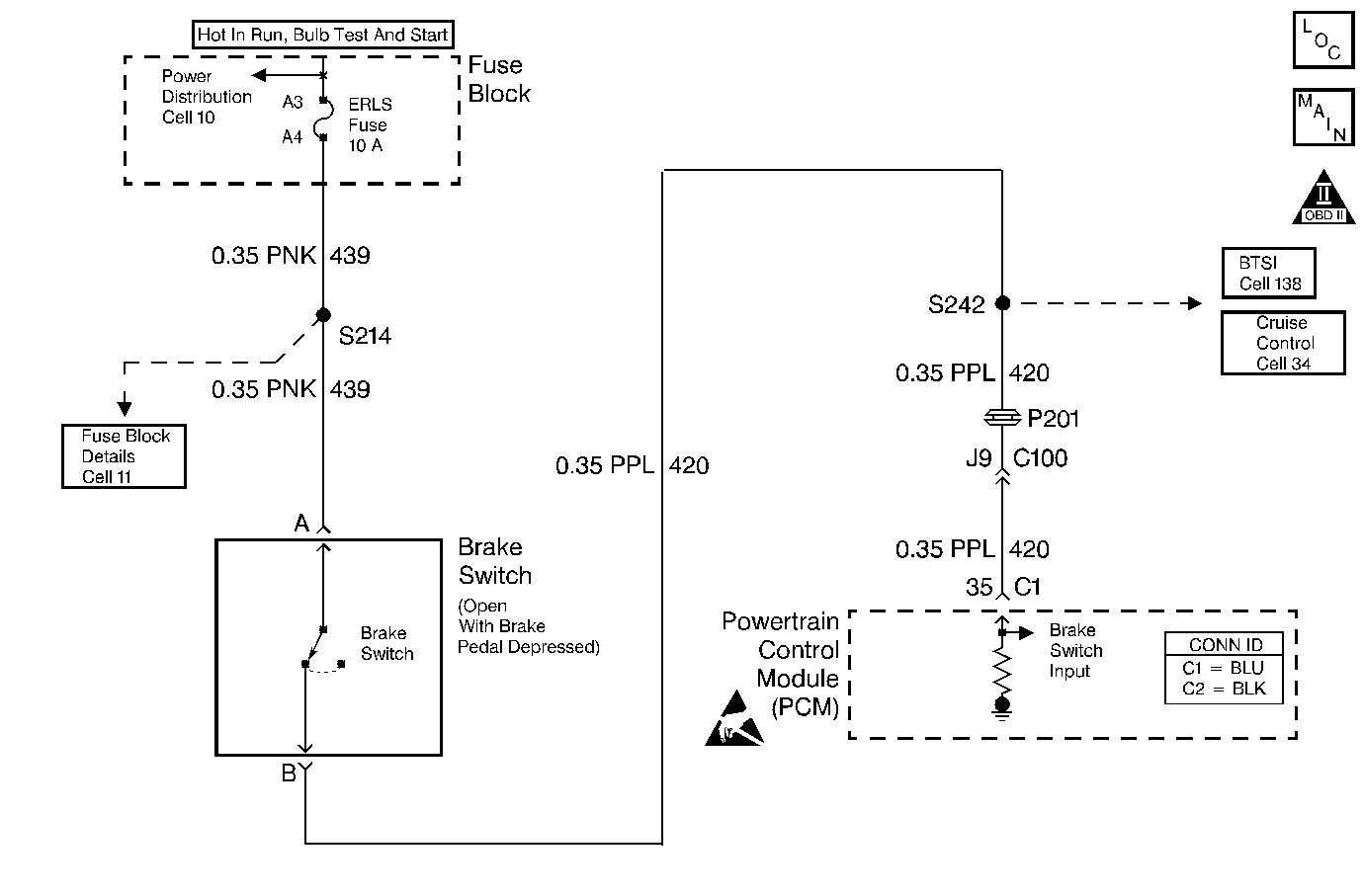
Circuit Description
The brake switch indicates brake pedal status to the powertrain control module (PCM). The normally-closed switch supplies battery voltage on circuit 420 to the PCM. Applying the brake pedal opens the switch, interrupting voltage to the PCM. While the brake pedal is not applied, the PCM receives constant voltage. If the PCM receives 0 volts at the brake switch input with the torque converter clutch (TCC) engaged, the PCM de-energizes the torque converter clutch solenoid valve (TCC solenoid valve) . The PCM disregards the brake switch input for TCC scheduling if there is a brake switch circuit fault. Refer to Diagnostic Aids.
When the PCM detects an open switch circuit (0 volts, low input) during accelerations, then DTC P0719 sets. DTC P0719 is a type D DTC.
Conditions for Running the DTC
No Vehicle Speed Sensor DTCs P0502 or P0503.
Conditions for Setting the DTC
| • | The vehicle speed is less than 8 km/h (5 mph), |
| then the vehicle speed is 8-32 km/h (5-20 mph) for 3 seconds, |
| then the vehicle speed is greater than 32 km/h (20 mph) for 6 seconds. |
| • | The PCM detects an open brake switch or circuit (0 volts) for 8 acceleration cycles. |
Action Taken When the DTC Sets
| • | The PCM does not illuminate the malfunction indicator lamp (MIL). |
| • | DTC P0719 stores in PCM history. |
Conditions for Clearing the DTC
| • | A scan tool clears the DTC from PCM history. |
| • | The PCM clears the DTC from PCM history if the vehicle completes 40 consecutive warm-up cycles without a non-emission related diagnosis fault occurring. |
Diagnostic Aids
| • | If the PCM detects a brake switch fault, then the brake switch input is disregarded for TCC scheduling. The PCM then uses throttle position and vehicle speed input to determine TCC application and release. Use of these inputs may result in a noticeable, harsh apply, or abrupt release of the TCC. |
| • | Inspect the brake switch for proper adjustment. |
| • | Inspect the wiring at the PCM, the brake switch connector and all other circuit connecting points for the following conditions: |
| - | A backed out terminal |
| - | A damaged terminal |
| - | Reduced terminal tension |
| - | A chafed wire |
| - | A broken wire inside the insulation |
| - | Moisture intrusion |
| - | Corrosion |
| • | When diagnosing for an intermittent short or open condition, massage the wiring harness while watching the test equipment for a change. |
Test Description
The numbers below refer to the step numbers on the diagnostic table.
-
If you disconnect the brake switch connector and observe the scan tool brake switch status change, with the jumper wire in place, then a brake switch is the only possible cause.
-
A short to ground in circuit 439 would open the ERLS fuse.
-
If the brake switch is properly adjusted, then you must replace the switch.
-
Replace the PCM only after you have completed the preceding diagnostic steps.
Step | Action | Value(s) | Yes | No | ||||||
|---|---|---|---|---|---|---|---|---|---|---|
1 | Was the Powertrain On-Board Diagnostic (OBD) System Check performed? | -- | ||||||||
Important: Before clearing the DTCs, use the scan tool in order to record the Failure Records. Using the Clear Info function erases the Failure Records from the PCM. Did the Brake Switch status change from Open to Closed? | -- | |||||||||
Refer to General Electrical Diagnosis in Wiring Systems. Was the fuse open? | -- | |||||||||
4 | Inspect circuit 439 for a short to ground. Important:: The condition that affects this circuit may exist in other connecting branches of the circuit. Refer to Power Distribution Schematics for complete circuit distribution. Refer to General Electrical Diagnosis in Wiring Systems. Was the condition found? | -- | -- | |||||||
Inspect the switch for proper adjustment. Is the switch out of adjustment? | -- | |||||||||
6 | Adjust the switch. Refer to Stop Lamp Switch Adjustment in Hydraulic Brakes. Is the repair complete? | -- | -- | |||||||
7 | Inspect circuit 439 for an open. Refer to General Electrical Diagnosis in Wiring Systems. Was the condition found? | -- | ||||||||
8 | Replace the switch. Refer to Stop Lamp Switch Replacement in Hydraulic Brakes. Is the replacement complete? | -- | -- | |||||||
9 | Inspect circuit 420 for an open. Refer to General Electrical Diagnosis in Wiring Systems. Was the condition found? | -- | ||||||||
10 | Repair the wiring as necessary. Refer to Wiring Repairs in Wiring Systems. Is the repair complete? | -- | -- | |||||||
Replace the PCM. Refer to PCM Replacement/Programming in Engine Controls. Is the replacement complete? | -- | -- | ||||||||
12 | Perform the following procedure in order to verify the repair:
Has the test run and passed? | -- | System OK |
